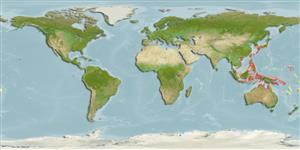Common names from other countries
>
Blenniiformes (Blennies) >
Blenniidae (Combtooth blennies) > Salariinae
Etymology: Rhabdoblennius: Greek, rhabdos = stick + Greek, blennios = mucus (Ref. 45335).
More on author: Günther.
Environment: milieu / climate zone / depth range / distribution range
Écologie
marin récifal; profondeur 0 - 2 m (Ref. 76835). Temperate
Western Pacific Ocean: southern Japan to Taiwan, Philippines and Malaysia.
Taille / Poids / Âge
Maturity: Lm ? range ? - ? cm
Max length : 8.3 cm SL mâle / non sexé; (Ref. 76835); 5.6 cm SL (female)
Épines dorsales (Total): 12; Rayons mous dorsaux (Total): 18-22; Épines anales 2; Rayons mous anaux: 19 - 23. Teeth on jaws immovable, fewer than 40 in each jaw. Terminal anal fin ray connected by membrane to caudal peduncle. Nasal and supraorbital cirri simple, nuchal cirri absent. Both sexes with occipital crest.
Facultative air-breathing (Ref. 126274); Adults are usually found on the outer reef front of surge channels and pools, exposed to heavy surf. Oviparous. Eggs are demersal and adhesive (Ref. 205), and are attached to the substrate via a filamentous, adhesive pad or pedestal (Ref. 94114). Larvae are planktonic, often found in shallow, coastal waters (Ref. 94114).
Life cycle and mating behavior
Maturité | Reproduction | Frai | Œufs | Fécondité | Larves
Oviparous, distinct pairing (Ref. 205).
Bath, H., 2004. Revision of the genus Rhabdoblennius Whitley (Pisces: Blenniidae: Salariinae), with descriptions of two new species. Stuttg. Beitr. Naturkd. (A Biol.) 669:1-28. (Ref. 76835)
Statut dans la liste rouge de l'IUCN (Ref. 130435)
CITES (Ref. 128078)
Not Evaluated
Menace pour l'homme
Harmless
Utilisations par l'homme
Plus d'informations
RéférencesAquacultureProfil d'aquacultureSouchesGénétiqueElectrophoresesHéritabilitéPathologiesTraitementMass conversion
CollaborateursImagesStamps, Coins Misc.SonsCiguateraVitesseType de nageSurface branchialeOtolithesCerveauxVision
Outils
Articles particuliers
Télécharger en XML
Sources Internet
Estimates based on models
Preferred temperature (Ref.
115969): 21.6 - 29.2, mean 28.7 (based on 920 cells).
Phylogenetic diversity index (Ref.
82804): PD
50 = 0.5312 [Uniqueness, from 0.5 = low to 2.0 = high].
Bayesian length-weight: a=0.01072 (0.00480 - 0.02393), b=3.01 (2.82 - 3.20), in cm Total Length, based on LWR estimates for this (Sub)family-body shape (Ref.
93245).
Niveau trophique (Ref.
69278): 2.0 ±0.00 se; based on food items.
Résilience (Ref.
120179): Haut, temps minimum de doublement de population inférieur à 15 mois (Preliminary K or Fecundity.).
Fishing Vulnerability (Ref.
59153): Low vulnerability (10 of 100).
